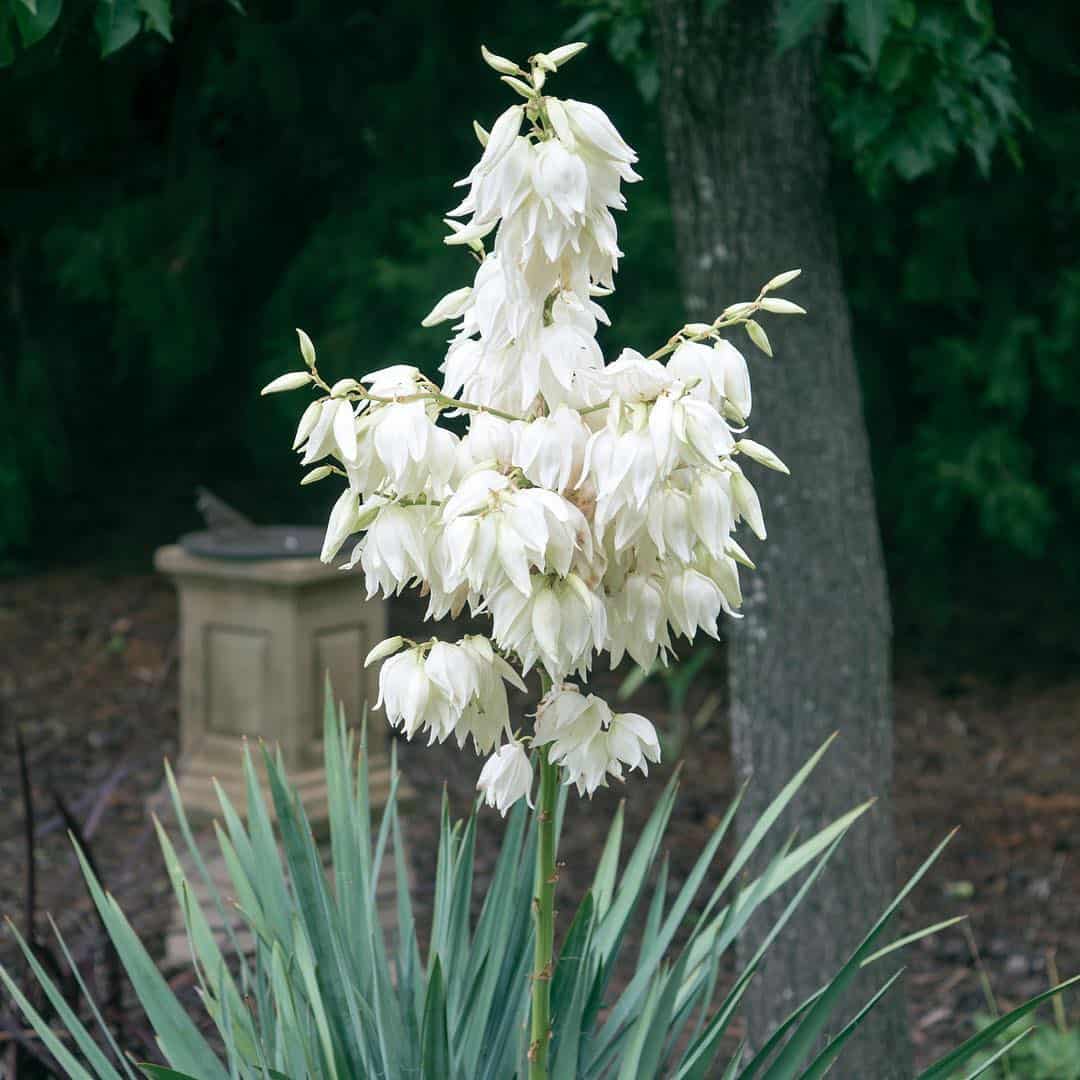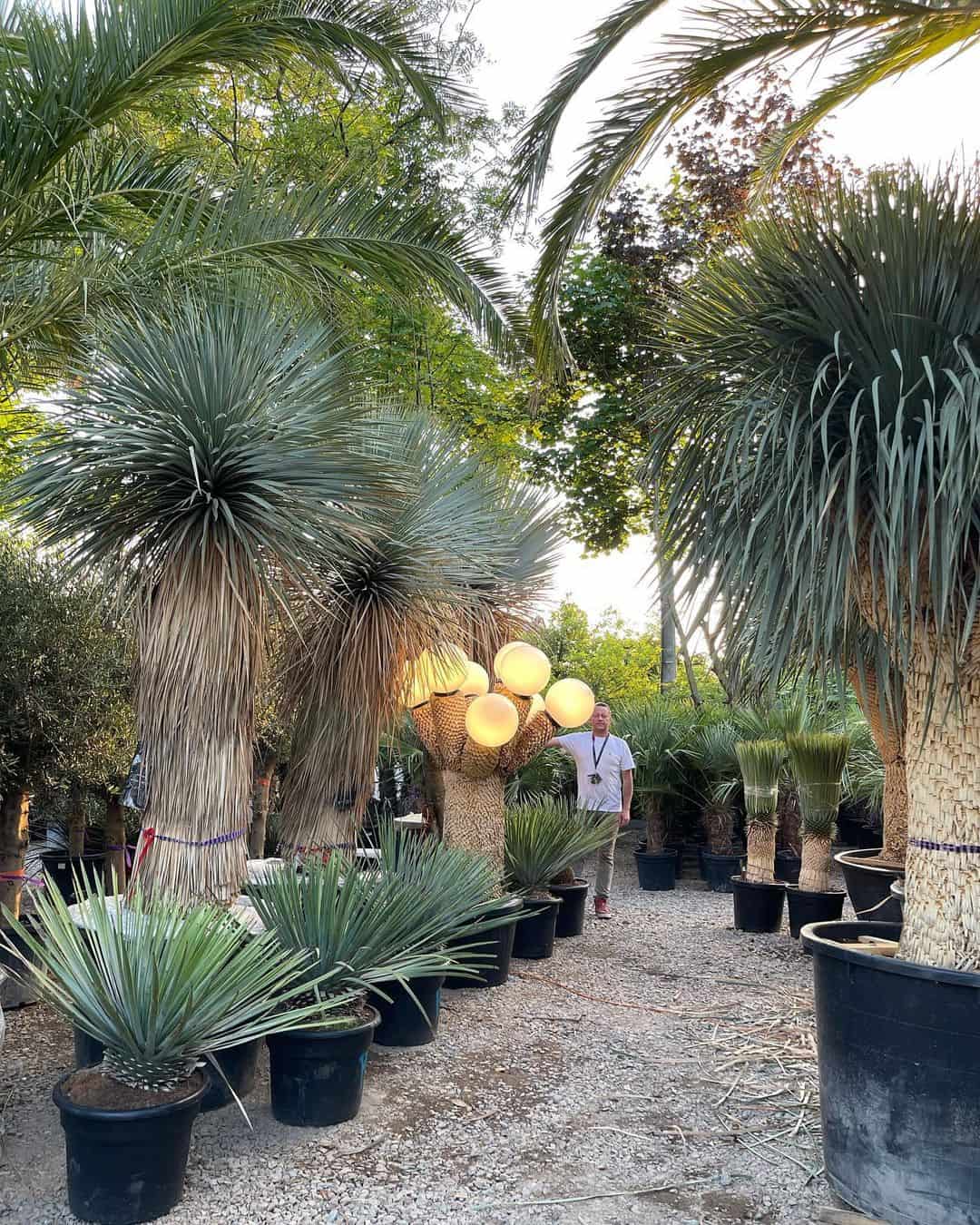Spending a big chunk of my youth in the West and desert southwest, the Yucca brings back memories of riding my banana seat bike, warm humidity-free evenings, and arid gardens. So I was quite surprised to find it recently here in New England. I took on a new project to restore a historic landscape, and surprisingly (or perhaps not surprisingly, as I learn more about the amazing woman who originally created the garden), she grew Yucca.
I am not yet sure what variety it was, but seeing this plant, planted purposefully in her turn-of-the-century New England garden, was unexpected – I hardly ever see yucca here now. Intrigued, I’ve explored further and learned quite a few things about this amazing native plant – and I am excited to plant many more of them.

There aren’t many of the original plants from that garden remaining. Seventy years after this garden was abandoned, the most notable things that remain are a couple of roses, the peonies, and yucca. It is reported that yucca lives between 20-50 years in the landscape and some as much as 100 years. The ones I discovered in this garden are more than 70 years old – a testament to the toughness of these architectural plants.
Adam’s Needle, Spanish Bayonet, or Bear Grass
The yucca plant goes by a few names. Adam’s needle and Spanish bayonet are the most common, but occasionally, it is also called bear grass. Here in New England, Yucca Filamentosa is easy to grow (it is hardy to zone 4). Massachusetts and New York are at the northern and easternmost edges of a native range that runs all the way south to Florida and west to Nebraska and Texas.
It is a striking perennial plant that adds a touch of exotic charm to any garden. This hardy and versatile species thrives in a range of growing conditions and will satisfy the desire so many people have for the structure of more architectural plants like agave, but it will thrive where many agave will not.

Growing Yucca in Your Garden
To grow Yucca filamentosa successfully, ensure it receives full sun (though it will tolerate partial shade ), well-draining soil, and good air circulation. This resilient plant can tolerate drought conditions, making it a low-maintenance addition to your landscape.
Once it is established, it will flower annually at the same time every year. Unlike agave, which sends up death flowers (And they die after blooming) – a yucca will continue to flower for decades.
The flower stalks are one of the most spectacular and impressive things a home gardener can cultivate. The yucca plant’s foliage clumps feature blade-like leaves that spiral out from a basal rosette (like the agave), and this part of the plant may stand only a foot or two tall.
But the flowers of this plant are a particular spectacle. They will grow many feet above the plant on huge stalks, as high as 5-6 feet (or more, depending on variety). The stalks are covered with creamy-colored bell-shaped flowers that have a strong, sweet smell (that can be pungent) that is heightened in the evenings. It is this fragrance that attracts yucca moths.
Yucca moth larvae eat the plant’s seeds, and the eggs of the moth species are laid in the flowers.

How to Design with Yucca in the Landscape
Pair this sharp and pointy plant with other drought-tolerant companions like sedums, agaves, and ornamental grasses for a visually captivating and sustainable garden design. The spiky, architectural nature of Yucca filamentosa beautifully contrasts with the soft textures of ornamental grasses and the vibrant hues of sedums, creating a captivating garden display that’s both visually appealing and easy to care for.
I am growing this native plant in the absolute worst conditions of my garden. I haphazardly tossed them out at the back of the vegetable patch where the topsoil is thin; I have historically used lots of gravel to make paths and where the sun bakes it all summer. In this less-than-ideal garden location, it is completely happy and thriving. I have planted similarly striking foxtail lilies nearby, who also seem to love this more neglected and rough area than the other more enriched areas of my landscape.
When I planted it there, I did it because it was out of the way. I wasn’t sure what else to do with it, and I thought I might not even like it – but its toughness and ability to thrive in the poor soil and obnoxious conditions have endeared itself to me. Now, I am planning other plantings around it to heighten them as a beautiful feature.

Be Careful where you plant Yucca filamentosa
Don’t plant this where little kids or pets can fall into it easily. It is a sharp plant, and it will hurt people. Instead, put it at the back or center of a planting bed away from walkways. It is a real focal point plant, so this works best anyway – you can build the rest of your planting plan around it.
If you live in an area where planting for security is important, this is a plant you might consider placing beneath windows or other entry points into your home to deter break-ins.
It is visually at home in southwest-themed landscapes – but I think that is a bit of a type-casting. These plants aren’t often used in the USA in formal or other garden design styles – but they should be. I’d encourage you to experiment and try adding them to cottage or other garden styles.

Yucca Filamentosa Soil Requirements: The Right Foundation for Success
Adam’s Needle thrives when planted in well-draining soil. It will absolutely abhor waterlogged conditions, so ensure your garden soil drains well. Sandy or loamy soils are ideal as they allow excess water to escape, preventing root rot. If your soil has a high clay content and tends to retain water, consider amending it with sand or organic matter to improve drainage or, better yet- grow yucca in a pot.
Yucca is very tolerant of salt spray (making it a solid choice for coastal gardens), and it is stylistically at home in the dry soils of a typical rock garden.
Yucca roots appreciate good aeration. Loosening the soil before planting and mulching around the base of the plant can help maintain an airy root environment.
Hardy into zone 4, this plant can be an interesting and exciting accent or focal point in any garden across the US. Just don’t over-water it in the summer months.

The most exciting Yucca filamentosa Varieties:
Yucca filamentosa is native to the southeastern United States and north to New England.
There are many commercially cultivated varieties that feature a variegated leaf. Yucca filamentosa ‘color guard,’ Y. ‘Bright Edge,’ and Y. ‘Gold Edge’ are all good choices for a two-toned leaf.
My personal favorite variety is Yucca filamentosa ‘Excalibur.’ Excalibur is a beautiful silvery blue color and is a great contrast to other plants, not just in shape and form but in the rarer blue leaf color.
If you want to stay with green leaves – try growing Yucca filamentosa ‘Ivory Tower,’ which is often planted in a container to highlight its beautiful blooms.
All yucca are evergreen, and though the plant shape and sharpness will often slump slightly in the wet of winter, it will rebound in the summer.


Here are a few more interesting reasons to grow Adam’s Needle (Yucca filamentosa ):
1) While the roots are toxic, Yucca flowers are edible and can be used in salads. Add the creamy white flowers for a sweet, followed by a bitter taste. The black seeds can also be ground to make flour.
2) Native Americans use various parts of the plant for medicinal and practical purposes. The leaves contain strong, fibrous threads that can be used for cordage and crafts. (The name ‘filamentosa’ is indicative of the thread-like- filaments along the leaf edges of the leaves. Watch yucca get spun into rope here – this rope is then used to make baskets and sandals. The roots are still used to make soap.

3) Yucca filamentosa’s fibrous leaves make it fire-resistant, a valuable feature for landscaping in fire-prone areas. It is also often one of the first plants to colonize disturbed or barren landscapes.
In the presence of wildfires, Yucca filamentosa releases seeds that take advantage of the post-fire landscape for germination.
4) Yucca filamentosa is generally resistant to deer browsing. (though I have found mine chewed down – but I suspect by woodchucks). They recovered quickly, though, and I have found that after the first attack, the grazing animal – whatever it was – hasn’t returned for over three years.

5) In the early 20th century, the stiff, sharp-pointed leaves of Yucca filamentosa were used as replacements for phonograph needles.
6) The famed American author Willa Cather featured Yucca filamentosa in her novel “O Pioneers!” as a symbol of the tenacity of early settlers.
7) Yucca filamentosa belongs to the family Asparagaceae (the asparagus family), which also includes familiar plants like asparagus and agaves.
TL;DR for Yucca Filamentosa
Yucca filamentosa is exceptionally drought-tolerant, making it a resilient choice for arid landscapes and gardens using xeriscaping techniques. It is also extremely low maintenance and does not require any pruning, nor does it have any significant pest issues.
The plant’s striking, sword-like leaves and tall flower spikes add architectural interest to gardens.
Yucca filamentosa produces bell-shaped, creamy-white flowers on tall stalks, making it a favorite for gardeners.
It is a pollinator magnet – Its flowers attract bees, butterflies, and the yucca moth.
They are a great companion plant to Eremurus (Foxtail lIlies) (I have this pairing in my own garden, and it is one of my favorites).

